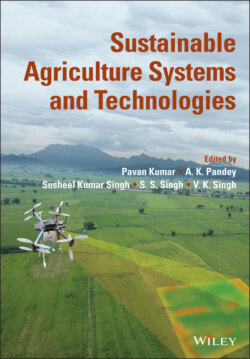Читать книгу Sustainable Agriculture Systems and Technologies - Группа авторов - Страница 10
Preface
ОглавлениеTechnological change has been the major driving force for increasing agricultural productivity and promoting agriculture development across the globe. In the past, the choice of technologies and their adoption was to increase production, productivity, and farm incomes. However, with changing agrarian economy, food habits, and climate scenario, demand for nutritious food and ecofriendly cultivation practices are becoming a major concern. Over many decades, policies for agriculture, trade, research and development, education, and training have been strong influences on technology adoption, agricultural production, and farm management. Agriculture is one of the most important sources of food nutrition, income, and employment in most of the developing world, including India. With passes of time, predominant rice, wheat, and other grains producing tracts have started showing symptoms of fatigue due to several eco‐physical and socioeconomic constraints. Effects are witnessed as frequent drought occurrence, soil carbon depletion and degradation, and reduced farm income. Under these circumstances, cultivators, advisors, and policy makers are facing technological complexities, which are either available or under development, causing pressure on agricultural research and advisory services. Although, few attempts have been made in establishing the role of climate on crop productivity in current and future scenarios. But it does not consider non‐climatic factors such as land use, technological advancement, change in irrigation pattern, soil fertility, and crop destruction due to insects, pests and diseases. Integrating all these may become robust tools for decision‐ and policy‐making to prioritize the vulnerable zones that need immediate attention.
This book covers significant and updated contribution in the field of sustainable agriculture systems and technologies linked to climate change. The updated knowledge from countries like India, Indonesia, Japan, Sri Lanka, Iran, and China, is presented in this book through selected case studies for major thematic areas that have basic preliminary concepts and elaborates the scientific understanding of the relationship between sustainable agriculture systems and climatic drivers. The book has been separated into four major themes, each having subject‐specific chapters to develop the concept and to present the findings in a lucid way that is useful for a wide range of readers. While the range of applications and innovative techniques is constantly increasing, this book provides a summary of key case studies to provide the most updated information. Chapters incorporate multisource data and information that offer critical understanding to explain the causes and effects of environmental changes linked to sustainable agriculture systems. This book will be of interest to researchers and practitioners in the field of agriculture, remote sensing, geographical information, and policy studies, etc., related to agricultural systems. Also, researchers, graduate, and postgraduate students of various disciplines, planners, and policy makers will find valuable information in this book. We believe that the book will be read by people with a common interest in sustainable development and other diverse backgrounds within earth observation.
The scientific quality of the book was ensured by a rigorous review process where leading researchers from India, Indonesia, Japan, Sri Lanka, Iran, and China, participated to provide constructive comments to improve the chapters. Due to the confidentiality of the review process, we are unable to provide their name; however, we are deeply indebted and thankful for their voluntary support. On behalf of the team of authors, we express our gratitude to the entire crew of Wiley for all kind of assistance to make this successful endeavor.
Pavan Kumar A. K. Pandey Susheel Kumar Singh S. S. Singh V. K. Singh
